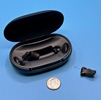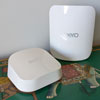What do Apple, Sony, Dell, Acer, Lenovo and HP have in common? They all make laptops, sure, but each has been forced to recall their laptop batteries because of the risk of fire. In fact, since 2002, there have been more than 40 recalls due to explosion or fire risk from lithium ion batteries in laptops, phones and other electronic devices.
And when lithium ion batteries fail, they can do so in spectacular fashion. As the video below from computer support company PC Pitstop shows, lithium ion battery fires not only burn extremely hot (up to 1000 degrees fahrenheit), but can explode, sending chunks of burning metal across the room.
Lithium ion fires are also difficult to put out. Throwing water on one can actually makes matters worse. Experts recommend a Class D commercial fire extinguisher, not something most of us have sitting around the house.
UPDATE 8/9/2013: Reports from the Fire Prevention Research Institute and the FAA indicate that lithium ion battery fires do not require a Class D extinguisher—water works effectively to extinguish the flames and cool the cells to prevent further thermal runaway (thank you to Mark Rogers, Director, Dangerous Goods Programs for the Air Line Pilots Association for bringing the FAA report to my attention). If your device is plugged into an electrical outlet, it may be wise to unplug it, if possible, prior to extinguishing with water.
What causes lithium ion batteries to fail?
Lithium ion batteries have circuitry inside to prevent overcharging and short circuits, but if this circuitry is damaged, the battery could become overheated, resulting in a process known as "thermal runaway." Thermal runaway is a chemical process where the battery generates heat, causing additional reactions that generate more heat, and so on until the entire thing finally erupts in flame. Manufacturing defects can also result in thermal runaway.
How much heat it takes to get a battery to go into thermal runaway may vary based on the type of battery. According to Tony Olson, CEO of D2 Worldwide, which conducted the lithium ion battery test for PC Pitstop, thermal runaway can occur if the battery is heated to anywhere from 140 degrees fahrenheit up to 350 degree fahrenheit. Not standard household temperatures, obviously, but possible if the battery experiences a failure.
While the likelihood of lithium ion battery fires is still very low, two factors are increasing the risks. First is the simple fact that it's becoming far more common for us to own devices containing lithium ion batteries, including laptops, tablets, smartphones, Kindles, etc. Secondly, as manufacturers are pushing to put more and more power into these devices, the results of a failure become more pronounced.
To help avoid issues with your batteries, the Consumer Product Safety Commission recommends the following safety tips:
- Only purchase batteries and chargers directly from the manufacturer or from a manufacturer-recommended source. Buying counterfeit or poorly manufactured batteries increases the chance of having an issue.
- Do not let a loose battery come in contact with metal objects, such as coins, keys, or jewelry. Metal objects can cross the electrical connections and cause an incident if the internal protection circuitry isn't functioning correctly.
- Do not crush, puncture or put a high degree of pressure on the battery, as this can cause an internal short-circuit, resulting in overheating.
- Do not place the phone or batteries in areas that may get very hot, such as on or near a cooking surface, cooking appliance, iron, radiator or the dashboard of your car in the summer.
- If you drop your phone or laptop on a hard surface, it can potentially cause damage the battery. If you suspect damage to the battery, take it to a service center for inspection.
- If your phone gets wet, even if the device dries and operates normally, the battery contacts or circuitry could slowly corrode and pose a safety hazard.
And if you see any bulging, leakage or other abnormality from your battery, stop using it immediately.
















From Greg on March 23, 2014 :: 10:58 pm
It is my understanding that there are two types of lithium ion batteries. One is simply LiIon and the other is LiIon Polymer ... LiPo. It is also my understanding that the LiPo batteries are primarily used in consumer electronics like cell phones & computers and are the most dangerous of the two types.
Any thoughts or information on this?
Reply